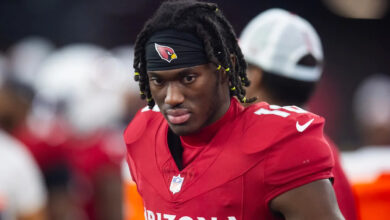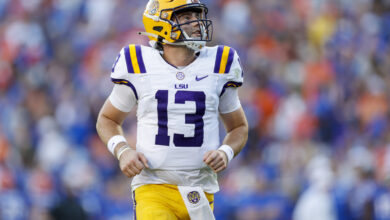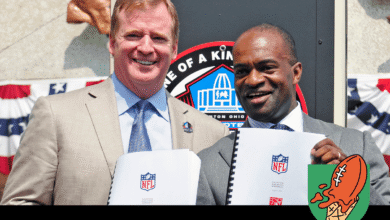WR Rookie Production | What to Expect | 2025 NFL Season
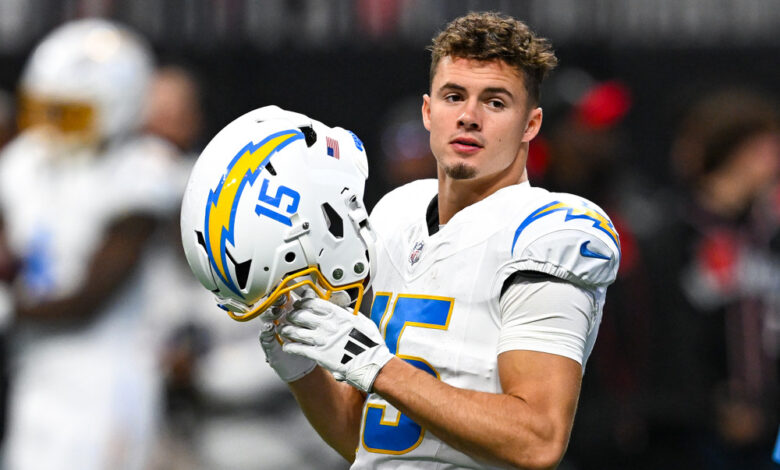
By evaluating previous WR rookie production, we can help set realistic expectations for the 2025 NFL rookie class. We’ll examine trends from the past 10 NFL seasons (2015–2024) and draw insights into how rookies typically perform in their first year, breaking down the data position by position. Then, we’ll project how that might translate to this year’s rookie class. Let’s move over to the WR position.
Wide Receiver | Overview
- 325 WRs drafted
- 41 WRs have posted WR4 or better numbers (12.62%)
- 12 WRs have posted a WR2 or better numbers (3.69%)
- 6 WRs have posted WR1 numbers (1.85%)
Elite Rookie WR Seasons
| Year | Player | Fantasy Finish | FPPG | FPPG (1-9) | FPPG (10-17/18) | Games Played | Targets | Yards | TDs | QB | Target Share | Slot Snaps |
| 2016 | Michael Thomas | 8 | 14 | 13.9 | 14.1 | 15 | 121 | 1137 | 9 | Drew Brees | 19.4% | 87th |
| 2020 | Justin Jefferson | 8 | 14.4 | 12.5 | 16.3 | 16 | 125 | 1400 | 7 | Kirk Cousins | 26.5% | 59th |
| 2021 | Ja’Marr Chase | 6 | 15.5 | 16.2 | 14.7 | 17 | 128 | 1455 | 13 | Joe Burrow | 23.9% | 95th |
| 2023 | Puka Nacua | 7 | 14.5 | 14.1 | 14.9 | 17 | 160 | 1486 | 6 | Matthew Stafford | 28.7% | 40th |
| 2024 | Malik Nabers | 8 | 14.6 | 14.5 | 14.7 | 15 | 170 | 1204 | 7 | Daniel Jones | 34.9% | 54th |
| 2024 | Brian Thomas | 12 | 14.1 | 12.5 | 16 | 17 | 133 | 1282 | 10 | Trevor Lawrence | 25.5% | 52nd |
| Average | 14.5 | 14.0 | 15.1 | 16.2 | 139.5 | 1327.3 | 8.7 | 26.5% |
Key Takeaways
Elite rookie performances historically require the following:
- High Target Share
- The Pocker Passer QB
- Outside Receiver
Over the past decade, fantasy managers have become increasingly obsessed, and rightfully so, with finding the next elite rookie wide receiver for their dynasties. Wideout offers the longest windows of production in fantasy football other than quarterbacks. While the hype is always high, the reality is this: very few rookie receivers hit WR1 status in their 1st year.
In fact, over the last 10 years, only 6 rookie wide receivers have finished as WR1s in fantasy. So, what separates those six from the rest? After digging into the data, a few patterns start to emerge, and they all come down to opportunity, quarterback play, and their role in the offense.
Of those 6 WR1 rookie seasons, 5 receivers commanded a 20%+ target share on their teams. They weren’t just part of the offense; they were the offense. Every one of them saw at least 120 targets during their rookie campaign. That seems to be a good spot for a rookie to finish as a WR1, but sometimes that is not the case. Amari Cooper, Garrett Wilson, and Jayden Waddle were outliers in their rookie season as they would reach this mark but not finish as WR1s. The bottom line is that volume matters. A rookie needs to see consistent targets to break out, and that kind of usage doesn’t happen by accident. It occurs when the team builds its passing game around them.
The presence of a traditional pocket passer appears to have an impact on a rookie receiver. All 6 of these rookie WR1s played with quarterbacks who ran for under 300 rushing yards in that season. That doesn’t mean mobile quarterbacks can’t support WR1s, but it does make things interesting when evaluating rookie receivers.
Another trend was that none of these rookie WR1s were primary slot receivers. The best slot usage among the 6 was Puka Nacua, who ranked just 40th in slot snaps league-wide. This aligns with how the league values X and Z receivers versus slot-only players. Elite production usually comes from the outside, and these rookies were no exception.
Notably, we’ve seen a rookie WR1 in four of the last five seasons. The position is evolving, offenses are stretching the field more, and a new generation of young talent is entering the pro ranks, ready to play. So, yes, while it’s rare, the odds of a rookie wideout finishing as a WR1 are increasing.
Top 30 Finishes | WR Rookie Production
| Year | Player | Fantasy Finish | FPPG | FPPG (1-9) | FPPG (10-17/18) | Games Played | Targets | Yards | TDs | QB | Target Share | Slot Snaps |
| 2020 | Brandon Aiyuk | 17 | 12.9 | 11.7 | 14.5 | 12 | 60 | 748 | 5 | Nick Mullens | 24.2% | 86th |
| 2023 | Tank Dell | 16 | 12.9 | 12.3 | 13.9 | 11 | 75 | 709 | 7 | CJ Stroud | 20.4% | 109th |
| 2024 | Ladd McConkey | 18 | 12.5 | 10.7 | 14.3 | 16 | 112 | 1149 | 7 | Justin Herbert | 24.5% | 6th |
| 2021 | Jaylen Waddle | 23 | 12.1 | 10.4 | 14.3 | 16 | 140 | 1015 | 6 | Tua Tagovailoa | 24.8% | 15th |
| 2019 | A.J. Brown | 26 | 11.9 | 8.2 | 16,8 | 16 | 84 | 1051 | 8 | Ryan Tannehill | 19.5% | 131st |
| 2023 | Jayden Reed | 23 | 11.6 | 8.3 | 14.8 | 16 | 94 | 793 | 8 | Jordan love | 17.6% | 16th |
| 2017 | JuJu Smith-Schuster | 16 | 11.6 | 9.8 | 14.1 | 14 | 79 | 917 | 7 | Ben Roethlisberger | 16.6% | 21st |
| 2019 | Terry McLaurin | 28 | 11.6 | 12 | 11.2 | 14 | 93 | 919 | 7 | Case Keenum | 23.0% | 82nd |
| 2020 | Chase Claypool | 29 | 11.5 | 12.8 | 10.2 | 16 | 109 | 873 | 9 | Ben Roethlisberger | 16.7% | 109th |
| 2021 | Amon-Ra St. Brown | 27 | 11.4 | 5.8 | 15.8 | 17 | 119 | 912 | 5 | Jared Goff | 21.4% | 6th |
| 2020 | CeeDee Lamb | 31 | 11.3 | 11.2 | 11.4 | 16 | 111 | 935 | 5 | Dak Prescott | 18.0% | 2nd |
| 2023 | Jordan Addison | 28 | 11 | 12.9 | 8.8 | 17 | 108 | 911 | 10 | Kirk Cousins | 18.1% | 53rd |
| 2015 | Amari Cooper | 29 | 11 | 13.8 | 8.3 | 16 | 130 | 1070 | 6 | Derek Carr | 21.6% | N/A |
| 2018 | Calvin Ridley | 28 | 10.9 | 13.3 | 8.5 | 16 | 92 | 821 | 10 | Matt Ryan | 15.2% | 66th |
| 2023 | Rashee Rice | 30 | 10.8 | 8.6 | 13.6 | 16 | 102 | 938 | 7 | Patrick Mahomes. | 17.9% | 29th |
| 2022 | Chris Olave | 25 | 10.8 | 11.9 | 9.6 | 15 | 119 | 1042 | 4 | Andy Dalton | 26.7% | 60th |
| 2019 | Deebo Samuel | 33 | 10.7 | 7.1 | 13.9 | 15 | 81 | 802 | 3 | Jimmy Garoppolo | 18.1% | 84th |
| 2021 | Elijah Moore | 33 | 10.6 | 7.8 | 15.6 | 11 | 77 | 538 | 5 | Zach Wilson | 18.6% | 110th |
| 2016 | Tyreek Hill | 28 | 10.5 | 7.9 | 13.2 | 16 | 83 | 593 | 6 | Alex Smith | 15.5% | 63rd |
| 2023 | Zay Flowers | 32 | 10.5 | 8.5 | 13 | 16 | 108 | 858 | 5 | Lamar Jackson | 24.4% | 36th |
| Average | 11.2 | 10.1 | 12.4 | 15.5 | 102.3 | 896.5 | 6.6 | 19.9% |
While just 6 rookie receivers have managed WR1 finishes in the past decade, there have been 20 rookie WRs who have averaged between 10.5 and 12.9 fantasy points per game a threshold that often places them in WR2/WR3 territory. These players don’t quite hit elite levels, but they still make a significant impact for our teams.
Unlike the WR1 rookies who command massive target shares—this group is far more inconsistent in that department. Players like Calvin Ridley and Chase Claypool finished with a target share of under 17%, but their value came from efficiency and scoring touchdowns rather than heavy volume. These are the “boom” receivers not necessarily weekly starters early onbut capable of swinging matchups. While target share still matters, touchdown upside and explosive plays are often what propels these rookies into the WR2/WR3 tier.
Even in this second tier, the pocket passer trend continues. Most of the productive rookies in this range were supported by pass-first quarterbacks like Derek Carr, Jared Goff, and Alex Smith. There is one notable exception: Zay Flowers, who had a productive rookie season with Lamar Jackson, a true dual-threat QB. The majority of rookies in this tier still benefited from traditional passing offenses.

One major difference between elite and second-tier rookies is how much they line up in the slot. In this tier, at least 5 receivers in the past 10 years have finished in the top 20 in slot snaps. While no slot-heavy rookie has cracked WR1 territory, they do emerge as consistent PPR contributors in the WR2/WR3 range. A recent standout example is Ladd McConkey, who finished as WR18 per Fantasy Pros Fantasy Leaders while playing a majority of his snaps from the slot.
Another common theme in this tier is that rookie receivers often break out in the second half of the season. In the first 9 games, only 11 receivers averaged 10+ fantasy points. In the final 8 games, that number jumped to 16. Even more striking: no rookies were averaging 14+ PPG in the first half of the season, but 8 reached that level in the back half. This shows that while these players may not start strong, they often adjust and thrive once they get acclimated to the NFL. For fantasy managers, this is a tier to watch closely around midseason.
As dynasty managers, this may be the perfect time to buy low in-season for these rookie receivers. As mentioned, those rookies tend to break out in the second half of the season with upwards of 14 or more fantasy points per game. Of the 8 receivers who stepped up in the second half of the season, 5 of them saw a target share of 19% or more. It’s something to research as you get closer to mid-season in 2025 and look to buy low on some upside receivers for your dynasty teams.
Flex Range Impactors
| Year | Player | Fantasy Finish | FPPG | FPPG (1-9) | FPPG (10-17/18) | Games Played | Targets | Yards | TDs | QB | Target Share | Slot Snaps |
| 2019 | Darius Slayton | 34 | 10.4 | 7.7 | 13.2 | 14 | 84 | 740 | 8 | Daniel Jones | 16.6% | 147th |
| 2022 | Christian Watson | 30 | 10.3 | 3.6 | 15.2 | 14 | 66 | 611 | 7 | Aaron Rodgers | 15.2% | 91st |
| 2022 | Garrett Wilson | 31 | 10.2 | 9.5 | 11.1 | 17 | 147 | 1103 | 4 | Zach Wilson | 24.9% | 31st |
| 2020 | Tee Higgins | 39 | 10.1 | 10.8 | 9.4 | 16 | 108 | 908 | 6 | Joe Burrow | 19.1% | 53rd |
| 2019 | D.K. Metcalf | 42 | 9.9 | 10.9 | 8.6 | 16 | 100 | 900 | 7 | Russell Wilson | 20.3% | 87th |
| 2017 | Cooper Kupp | 30 | 9.7 | 8.5 | 11.1 | 15 | 94 | 869 | 5 | Jared Goff | 19.7% | 12th |
| 2024 | Marvin Harrison Jr. | 42 | 9.7 | 9.6 | 9.9 | 17 | 116 | 885 | 8 | Kyler Murray | 22.2% | 70th |
| 2016 | Sterling Shepard | 44 | 9.5 | 9.2 | 9.8 | 16 | 105 | 683 | 8 | Eli Manning | 17.6% | 1st |
| 2015 | Stefon Diggs | 43 | 9.5 | 14.6 | 6.3 | 13 | 84 | 720 | 4 | Teddy Bridgewater | 22.7% | N/A |
| 2024 | Xavier Worthy | 45 | 9.3 | 8.3 | 10.1 | 17 | 98 | 638 | 6 | Patrick Mahomes | 17.2% | 43rd |
| 2020 | Laviska Shenault Jr. | 46 | 9.2 | 7.3 | 11.6 | 14 | 79 | 600 | 5 | Gardner Minshew | 15.3% | 81st |
| 2024 | Jalen McMillan | 46 | 9 | 4.1 | 13.2 | 13 | 58 | 461 | 8 | Baker Mayfield | 13.4% | 84th |
| 2021 | DeVonta Smith | 44 | 9 | 9.4 | 8.6 | 17 | 104 | 916 | 5 | Jalen Hurts | 22.1% | 106th |
| 2022 | Drake London | 47 | 8.4 | 7.3 | 9.7 | 17 | 117 | 866 | 6 | Marcus Mariota | 29.4% | 103rd |
| 2018 | D.J. Moore | 38 | 8.1 | 6.5 | 9.6 | 16 | 82 | 788 | 2 | Cam Newton | 15.1% | 47th |
| Average | 9.5 | 8.5 | 10.5 | 15.5 | 96.1 | 779.2 | 5.9 | 19.% |
The gap between Tier 2 and Tier 3 of rookie receivers isn’t defined by drastic differences in play style or quarterback type rather by a moderate drop in production and opportunity. These receivers may not flash as often, but they still find ways to contribute and hold flex value. Unlike Tier 2 rookies, this group doesn’t typically catch fire in the second half of the season. The late-season bump seen in Tier 2 doesn’t happen here. The key difference? Their upside is capped, but they’re still playable and can surprise in the right spot. They may flash for a few games but nothing consistent for fantasy.
1st Round Wide Receivers
2nd Round Wide Receivers
Late-Round Wide Receivers (3 to 7)
- 45 WRs drafted in Round1
- 4 WRs Finished as a WR1 (8.89%)
- 18 WRs Finished WR4 or better (40%)
- 48 WRs drafted in Round 2
- 1 WRs Finished as a WR1 (2.22%)
- 14 WRs Finished WR4 or better (29.17%)
- 232 WRs drafted in Round 3 or later
- 1 WRs Finished as a WR1 (0.43%)
- 9 WRs Finished WR4 or better (3.88%)
- 0 WRs Finished Top 48 in Rounds 6 or 7
- 1 WR Finished Top 48 in Round 4
Expectations | WR Rookie Production
Two Way Hunter
Travis Hunter is one of the most intriguing rookie evaluations in recent memory. His rare two-way ability makes him a unicorn in the NFL, but it also presents real questions about his fantasy and on-field upside particularly on offense. The idea of Hunter seeing 120+ targets as a rookie feels ambitious. With second-year breakout candidate Brian Thomas Jr. emerging as a potential star in Jacksonville, Hunter may not command an alpha-level share right away. Notably, we have seen elite rookies like Puka Nacua and Ja’Marr Chase thrive alongside other high-level receivers.

The main concern: how much time will Hunter actually spend on defense? If the Jaguars use him heavily as a corner or safety, it’s going to be difficult for him to deliver elite wide receiver production consistently. Defensive snaps could limit his offensive usage, red-zone presence, and will increase his risk of injury or fatigue over a long season. While his two-way usage may cap his weekly ceiling in fantasy formats, his skill set suggests he could go on stretches of WR1-level performances. His floor sits in the Flex/WR3 range, particularly early in the season as his usage is figured out.
Panthers New WR1
Tetairoa McMillan projects as the Panthers’ WR1 of both the present and future, stepping into a wide-open receiver room where the top targets last year were Adam Thielen and Jalen Coker. Given the lack of established pass-catching competition, McMillan has a realistic shot at 120+ targets in his rookie season something that sets him apart from most first-year receivers.
McMillan profiles as a perimeter receiver, and he’ll likely see limited slot usage, resulting in a higher percentage chance of finishing as an outside receiver who thrives as rookie.
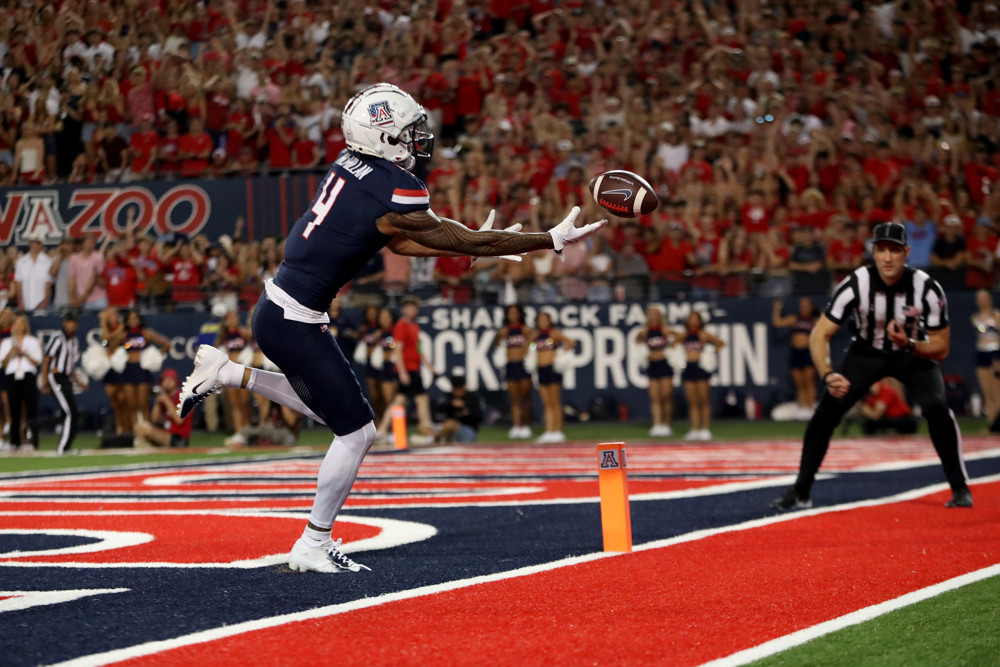
That said, the biggest limitation to McMillan’s fantasy ceiling is the current state of the Panthers offense and more specifically, Bryce Young. The former No. 1 overall pick has yet to prove he can elevate an NFL passing game. Last season, Carolina’s leading receiver finished with under 700 yards, and the offense as a whole struggled to sustain drives or generate explosive plays.
McMillan could have a touchdown ceiling under 5, which severely limits his weekly upside unless the Panthers make major strides in scoring efficiency. McMillan could have a season similar to players like Amari Cooper and Garrett Wilson in recent years. While they commanded a high target share, their overall production was limited by inefficient or underperforming offenses. McMillan might find himself in a similar situation, heavily involved in the passing game, but with his ceiling capped by the offense around him.
A Golden Packer
Matthew Golden was able to get 1st Round capital from the Packers. Golden has a prime opportunity to be the best among the 1st Round receivers due to his landing spot. The Packers are desperate for Golden to step up and be the team’s WR1, as so many other young receivers there have failed to do consistently. Golden can be what Christian Watson failed to be a downfield threat in the offense.

While the passing offense for Green Bay fell last year, if we expect a healthy Jordan Love to jump back up to his 2023 numbers. During Love’s 2023 season, he was able to get other Packers receiver Jayden Reed to reach Tier 2 rookie production. Golden’s speed and downfield threat may be what this offense needs to get going once again. Golden is going to be a big part of that comeback as he has the potential to land in Tier 2 of receivers as a rookie.
Tamp-Egbuka Buccaneers
Emeka Egbuka enters the NFL with elite talent good enough to be a WR1 on several teams right now. However, his rookie-year situation in Tampa Bay mirrors the path taken by Jaxon Smith-Njigba and Rome Odunze in their first seasons: talented players buried behind established veterans. Egbuka is slotted behind Mike Evans and a (hopefully) healthy Chris Godwin, which could severely cap his early target volume.
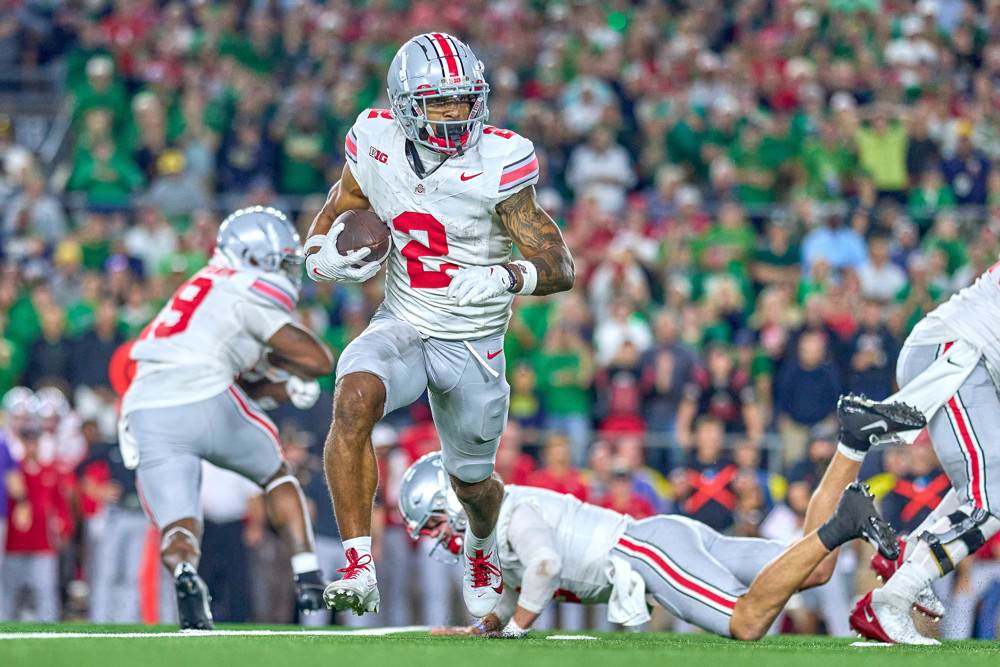
While Egbuka will have splash plays and flash his talent, his rookie year may be more about development and adjustment than consistent fantasy production. Neither JSN nor Odunze finished as top-48 fantasy WRs in their rookie seasons despite showing promise on the field. Egbuka could follow that same trajectory earning trust, learning the system, and waiting his turn.
Round 2 WR Rookie Production
The 2nd Round of the NFL Draft brought us four new wide receivers. None of them are coming into an opportunity to be the No. 1 pass catcher on the team. Here’s a closer look at each:
- Jayden Higgins looks to jump into the WR2 role in the Texans’ offense. Unless something happens to Nico Collins, Higgins likely offers upside but is inconsistent for the fantasy season.
- Luther Burden is going to be stuck behind two receivers who already have the front-runner job in the starting roles. While Ben Johnson was able to make Amon-Ra St. Brown a star in the slot, his rookie finish was WR27 on the year.
- Jack Bech could come into a bigger workload due to the talent at receiver in Las Vegas. Geno Smith has enjoyed throwing the ball around to different receivers, and it’s likely to be a run-first team offense under Pete Carroll.
- Tre Harris could have shot if the Chargers had a different offense. As long as Ladd McConkey is on the field, Harris would only reach the Tier 2 of receivers.
Jayden Higgins likely has the best shot among these receivers to produce solid numbers as a rookie due to the offense he is in. Tre Harris has a big opportunity, but he could be more of a second-half production rookie. This was one of the weaker top-tier talent draft classes, so expectations are lower.
Diamond in the Rough WR
It’s not easy to predict which Round 3 or later receivers will produce as rookies. As you see, only 9 rookies have done it in the last 10 years. I think opportunity is going to be a key factor for some of these 2025 rookies to have a shot, but some who do include:
- Kyle Williams who could secure the starting job in New England and see over 100 targets.
- Pat Bryant has been compared to Michael Thomas who was one of those rookies to finish in the Elite Tier.
- Elic Ayomanor or Xavier Restrapo could emerge with Cam Ward and be his WR1 despite Calvin Ridley’s presence on the team.
More than WR Rookie Production!
See what Steven Pintado discovered when he sifted through data of the last decade for the QB Position and the RB Position for expected rookie production:


